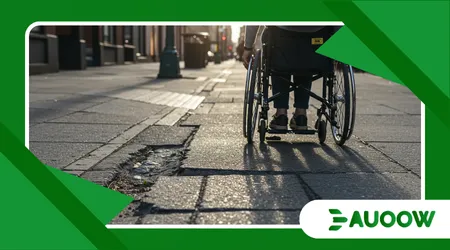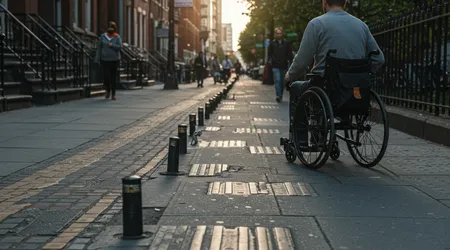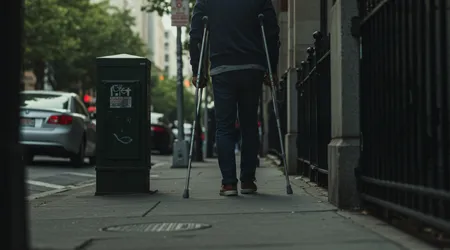Why Sidewalk Design Still Excludes Millions of Disabled People

Sidewalk design shapes how millions navigate cities daily, yet it often fails those with disabilities. Urban planners prioritize aesthetics over accessibility, leaving wheelchair users stranded at curbs without ramps.
Blind individuals dodge unexpected obstacles like bike racks. Parents pushing strollers share these frustrations too.
Cities promise inclusivity, but reality bites hard. Cracked pavements trip up mobility aid users. Steep slopes turn short walks into exhausting ordeals. We overlook these flaws until they affect us personally.
Imagine a world where streets welcome everyone equally. That vision remains distant in 2025. Recent updates to ADA guidelines push for change, but implementation lags. Communities demand better now.
Disabled advocates rally for reforms. Their voices highlight systemic neglect. Why build infrastructure that isolates? This question haunts urban development debates today.
The Persistent Barriers in Sidewalk Design
Uneven surfaces plague many streets. Wheelchair users jolt over cracks. These flaws stem from poor maintenance practices.
Cities install ramps inconsistently. Some lack proper gradients. Users risk tipping backward on steep inclines. Obstructions clutter pathways. Parked scooters block routes. Pedestrians with canes navigate around them blindly.
Temporary fixes worsen issues. Construction detours ignore accessibility. Disabled people detour blocks away. Vegetation overgrows edges. Bushes encroach on walkways. Low vision folks brush against thorns unexpectedly.
++ The Best Kitchen Gadgets for One-Handed Cooking
Crosswalk signals beep erratically. Deaf individuals miss audio cues. Visual alternatives remain rare. Potholes form after rains. Crutches sink into them. Injuries spike during wet seasons.
Lighting dims at night. Shadows hide hazards. Nighttime travel turns perilous for many. Snow removal skips corners. Icy patches trap wheelchairs. Winter isolates disabled residents further.

Real-Life Impacts on Disabled Communities
Maria wheels through her neighborhood. A missing curb cut forces her into traffic. Drivers honk impatiently. John taps his cane forward. Uneven bricks snag it repeatedly. He arrives late to appointments.
Communities suffer economically. Inaccessible paths limit job access. Unemployment rises among disabled groups. Social isolation grows. Friends cancel outings. Loneliness affects mental health deeply.
Children with disabilities play less. Playgrounds connect via flawed walks. Inclusion starts at streets. Families adapt routines. Parents carry kids over barriers. Exhaustion builds over time.
Emergency responses slow. Paramedics navigate obstacles. Seconds matter in crises. Public transport links fail. Bus stops sit beyond reach. Commuters abandon plans frustrated.
Also read: Accessible Cities 2025: Which Countries Are Leading the Way?
Advocates share stories online. Videos go viral. Awareness spreads rapidly in 2025. Support groups form locally. Members map problem spots. Data drives city petitions.
Policy Failures and Legal Gaps
Laws mandate accessibility. Enforcement varies wildly. Cities cite budget shortages often. ADA updates in 2023 aimed higher. Compliance deadlines slip repeatedly. Advocates sue for action.
Local ordinances conflict sometimes. State rules override weakly. Confusion stalls projects. Funding prioritizes cars. Pedestrian needs get scraps. Equity demands reallocation now.
International standards inspire. UN guidelines push universal design. US lags behind peers. Court cases highlight neglect. Settlements force repairs. Victories come slowly though.
Politicians promise reforms. Election cycles forget pledges. Voters hold them accountable. Regulations ignore tech aids. Apps map barriers digitally. Integration remains spotty.
Read more: Beyond Quick Fixes: Building Genuine Inclusive Experiences in Daily Digital Accessibility
Audits reveal noncompliance. Reports gather dust. Action plans evaporate quietly. Stakeholders collaborate rarely. Planners skip disabled input. Voices go unheard.
Paths to Inclusive Urban Planning

Engineers adopt new materials. Slip-resistant surfaces prevent falls. Durability extends lifespan. Communities pilot projects. Feedback loops refine designs. Success stories multiply.
Tech integrates sensors. Apps alert users to hazards. Real-time data empowers navigation. Training programs educate builders. Workshops stress empathy. Mindsets shift gradually.
Partnerships fund upgrades. Nonprofits join governments. Resources flow efficiently. Designers sketch with users. Co-creation yields practical solutions. Innovation thrives here.
Cities map accessibility comprehensively. GIS tools identify gaps. Prioritization follows data. Incentives reward compliance. Tax breaks encourage developers. Adoption accelerates.
Education campaigns inform public. Billboards highlight issues. Support builds organically. Global examples guide locally. Copenhagen’s ramps inspire adaptations. Lessons cross borders.
The Human Cost: A Deeper Dive
Why do we accept streets that function like obstacle courses for some? This rhetorical question underscores our collective oversight. Consider an analogy: Poor sidewalk design mirrors a locked library door knowledge inside, but entry denied to many.
One statistic reveals the toll: The CDC reports 57% of adults with mobility impairments engage in no physical activity, blaming inadequate urban infrastructure.
Recent research from CHI 2025 examines perceptions of sidewalk barriers across disability groups, informing personalized maps for better navigation.
In Boston, a wheelchair user named Alex avoids downtown. Narrow paths squeeze past crowds. Independence erodes daily.
Sarah, visually impaired in Seattle, fears bike lanes merging abruptly. Tactile warnings vanish mid-block. Confidence wanes.
Planners overlook cognitive needs. Complex intersections confuse autistic pedestrians. Signs overwhelm senses. Maintenance crews patch sporadically. Temporary asphalt humps trip users. Long-term fixes evade budgets.
Weather exacerbates flaws. Flooding pools at low points. Crutches slip on wet grates. Utility poles jut awkwardly. Narrow passages force detours. Frustration mounts quickly.
Shared spaces mix bikes. Conflicts arise often. Disabled folks yield space unwillingly. Ramp lips protrude sharply. Jolts strain joints. Pain lingers afterward.
Benches block turns. Rest spots hinder flow. Irony abounds here. Overhead branches droop low. Tall users duck constantly. Hazards multiply unnoticed.
| Common Sidewalk Design Barriers | Impact on Disabled Users | Prevalence (Based on 2024 Surveys) |
|---|---|---|
| Uneven Surfaces | Increased fall risk | 65% of urban sidewalks affected |
| Missing Curb Ramps | Blocks wheelchair access | 40% noncompliance in major cities |
| Obstructions (e.g., Poles) | Narrows pathways | 55% reported in accessibility audits |
| Steep Slopes | Exhausts mobility | 30% exceed ADA gradients |
| Poor Lighting | Heightens hazards at night | 50% in residential areas |
This table draws from a 2024 Transportation for America survey, high
Innovations Breaking the Mold
Startups develop AI mappers. Devices vibrate warnings. Users gain foresight. Materials science advances. Self-healing concrete smooths cracks. Maintenance eases up.
Universal design principles guide. One fix benefits all. Efficiency rises. Pilot cities test glow-in-dark paths. Night visibility improves. Safety soars.
Crowdsourcing apps collect data. Users report issues instantly. Responses quicken. Education embeds in curricula. Future planners learn inclusivity early. Change roots deep.
Grants target underserved areas. Rural towns upgrade finally. Equity spreads. Media spotlights successes. Documentaries inspire replication. Momentum builds.
Collaboratives form regionally. Best practices share freely. Progress accelerates. Evaluations measure impacts. Metrics track improvements. Accountability strengthens.
Conclusion: Toward Streets for Everyone
Sidewalk design evolves slowly, but urgency mounts in 2025. Disabled millions deserve seamless mobility now. Cities must listen actively.
Advocates drive the charge. Their persistence reshapes urban landscapes. Inclusion becomes standard. Imagine thriving communities. Accessible paths connect neighbors. Vibrancy flourishes everywhere.
Challenges persist, yet hope glimmers. Innovations promise transformation. Commitment seals the deal. We build for tomorrow today. Prioritize people over convenience. Equity defines progress.
Reflect on your streets. Spot the barriers? Action starts personally. Governments allocate more. Budgets reflect priorities. Change follows funding.
Tech aids the shift. Apps bridge gaps temporarily. Permanent fixes follow. Communities unite voices. Petitions gain traction. Reforms materialize swiftly. The future beckons inclusive. Sidewalk design adapts finally. Everyone benefits.
Frequently Asked Questions
What causes most sidewalk design* exclusions?
Poor planning and maintenance top the list. Barriers like cracks and missing ramps persist despite laws.
How can individuals help improve sidewalk design?
Report issues via city apps. Join advocacy groups. Vote for inclusive policies.
Are there apps for navigating accessible routes?
Yes, tools like AccessNow map barriers. They guide users around problems.
Why does sidewalk design matter for non-disabled people?
It benefits everyone parents with strollers, elderly walkers. Universal access strengthens communities.
What recent laws address sidewalk design flaws?
2023 PROWAG updates mandate better ramps and signals. Enforcement varies by city.
